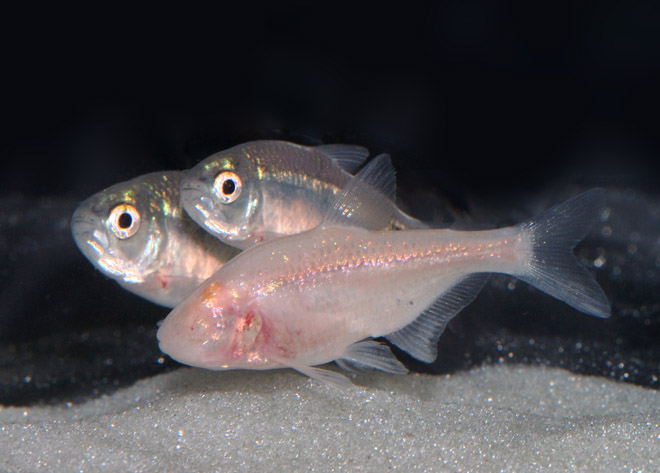Science News
Sleepless Cavefish
April 11, 2011

Cavefish are extraordinary creatures—three different populations have evolved separately to be blind and colorless. New York University researchers have now found they share another common trait—sleeplessness.
The scientists compared the sleeping patterns of the three cavefish and their surface kin, by basically annoying them awake. In one method, they determined that fish inactive for 60 seconds or more were sleeping. This conclusion was confirmed by tapping on the tank—fish inactive for this length of time were slow to respond to the tapping, a behavior consistent with being awoken from sleep. In the second method, the researchers deprived the fish sleep as a way of inducing subsequent sleep behavior. When animals are deprived the chance to sleep, there is a rebound effect, so at the next opportunity, they sleep for longer than normal periods to make up for the deprivation. The researchers tested this rebound effect by disturbing the sleep of fish all night by moving their containers once a minute. When observed the next day, they slept significantly increased amounts of time.
Using these methods, the researchers found that, over a 24-hour period, surface fish slept an average of over 800 minutes (over 13 hours!) while cavefish slept an average of between 110 to 250 minutes. The results are published in Current Biology.
Wired offers a possible reason why the cavefish need less sleep:
He [co-author Richard Borowsky] suspects that the cavefish evolved to be awake more often because of their unique environments. At the surface, fish have to use energy to escape predators during the day, but have plenty of food available. It’s the opposite in a cave, where the fish are the top predators but food is scarce. A fish that’s awake more has a better chance of snagging the rare morsel as it wanders by.
The researchers also sought to determine if genetics played a role in the varying sleep behaviors. To do this, they bred cave and surface fish and examined the sleep patterns of these hybrids. Their results showed that these hybrid fish nearly matched the sleep patterns of the cavefish, rather than those of the surface fish, demonstrating that cavefish carry a dominant gene for less sleep.
“In some ways, the sleep phenotypes of cavefish are similar to those of humans with sleep disorders,” explained Borowsky. “They go to sleep, but only for relatively short periods, then they awaken and remain awake for relatively long periods.”
“The next job is to identify the genes which are responsible for sleep modification in the cavefish. They would be good candidates for the genes responsible for insomnia and other sleep disorders in humans,” he added.
Image courtesy of New York University